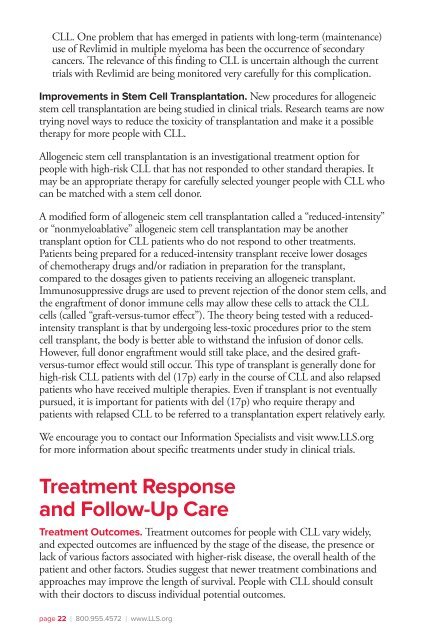Chronic Lymphocytic Leukemia - The Leukemia & Lymphoma Society
Chronic Lymphocytic Leukemia - The Leukemia & Lymphoma Society
Chronic Lymphocytic Leukemia - The Leukemia & Lymphoma Society
Create successful ePaper yourself
Turn your PDF publications into a flip-book with our unique Google optimized e-Paper software.
CLL. One problem that has emerged in patients with long-term (maintenance)<br />
use of Revlimid in multiple myeloma has been the occurrence of secondary<br />
cancers. <strong>The</strong> relevance of this finding to CLL is uncertain although the current<br />
trials with Revlimid are being monitored very carefully for this complication.<br />
Improvements in Stem Cell Transplantation. New procedures for allogeneic<br />
stem cell transplantation are being studied in clinical trials. Research teams are now<br />
trying novel ways to reduce the toxicity of transplantation and make it a possible<br />
therapy for more people with CLL.<br />
Allogeneic stem cell transplantation is an investigational treatment option for<br />
people with high-risk CLL that has not responded to other standard therapies. It<br />
may be an appropriate therapy for carefully selected younger people with CLL who<br />
can be matched with a stem cell donor.<br />
A modified form of allogeneic stem cell transplantation called a “reduced-intensity”<br />
or “nonmyeloablative” allogeneic stem cell transplantation may be another<br />
transplant option for CLL patients who do not respond to other treatments.<br />
Patients being prepared for a reduced-intensity transplant receive lower dosages<br />
of chemotherapy drugs and/or radiation in preparation for the transplant,<br />
compared to the dosages given to patients receiving an allogeneic transplant.<br />
Immunosuppressive drugs are used to prevent rejection of the donor stem cells, and<br />
the engraftment of donor immune cells may allow these cells to attack the CLL<br />
cells (called “graft-versus-tumor effect”). <strong>The</strong> theory being tested with a reducedintensity<br />
transplant is that by undergoing less-toxic procedures prior to the stem<br />
cell transplant, the body is better able to withstand the infusion of donor cells.<br />
However, full donor engraftment would still take place, and the desired graftversus-tumor<br />
effect would still occur. This type of transplant is generally done for<br />
high-risk CLL patients with del (17p) early in the course of CLL and also relapsed<br />
patients who have received multiple therapies. Even if transplant is not eventually<br />
pursued, it is important for patients with del (17p) who require therapy and<br />
patients with relapsed CLL to be referred to a transplantation expert relatively early.<br />
We encourage you to contact our Information Specialists and visit www.LLS.org<br />
for more information about specific treatments under study in clinical trials.<br />
Treatment Response<br />
and Follow-Up Care<br />
Treatment Outcomes. Treatment outcomes for people with CLL vary widely,<br />
and expected outcomes are influenced by the stage of the disease, the presence or<br />
lack of various factors associated with higher-risk disease, the overall health of the<br />
patient and other factors. Studies suggest that newer treatment combinations and<br />
approaches may improve the length of survival. People with CLL should consult<br />
with their doctors to discuss individual potential outcomes.<br />
page 22 I 800.955.4572 I www.LLS.org

















